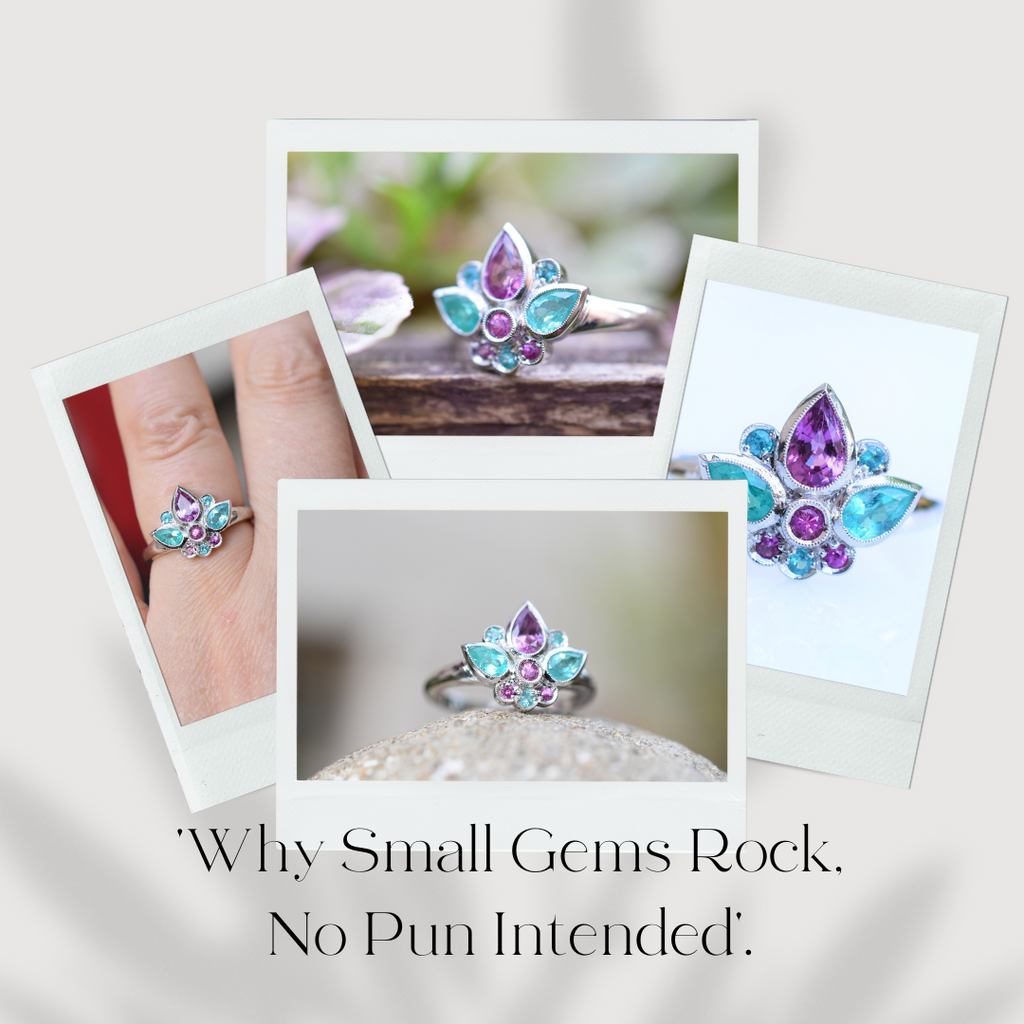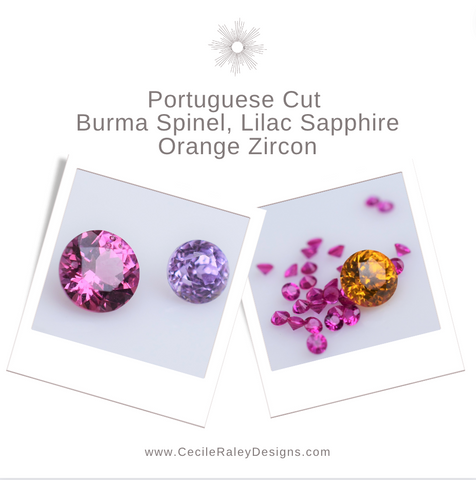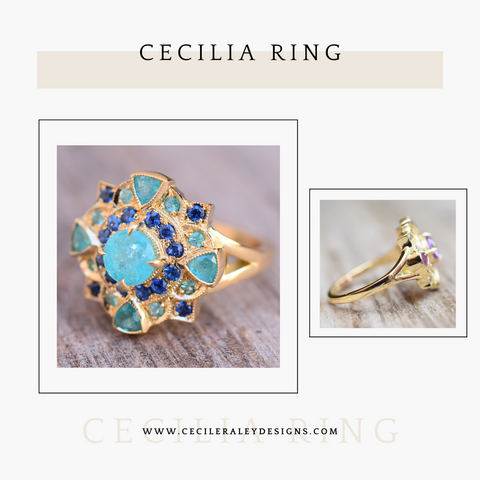Why Small Gems Rock, No Pun Intended

Everyone wants big gems. I know this all too well because I get asked for bigger almost every day – and I get to dish out a case of sticker shock almost every day, too. And yet I keep buying small gems. Under half a carat, under a quarter even, with 3mm sizes being pretty much my favorite. Many of the larger gems in my shop are ‘on memo’, meaning I borrow them for a few weeks or a few months, depending on privilege with the vendor, until they either go home with you or back to the owner.
Of course, one reason why I do this is financial. If I buy three small gems versus one large gem, I spread my risk out more. I have built up enough connections over the years so I can source larger gems as needed, borrow them long enough to show to clients, and I am trusted to reimburse the vendor should something happen (rule: never borrow what you can’t afford to lose).
But there are other, almost more important reasons, to go small. Let me give you two. The first one you may not guess but is incredibly important to me. And incredibly obvious once it’s said.
FACET SIZE
A diamond cut diamond (or other gem) has 58 facets. A really big diamond cut diamond also has 58 facets and a very small diamond cut diamond also has 58 facets. Diamond cuts are not my favorite (not enough bling for colored stones), but they are a great example to make my point: large gems have large facets, small gems have small facets. That is almost universal. Portuguese cuts have more facets, sometimes many more facets, but unless a cutter really feels like playing around, you again have larger facets on larger gems. And facets are what make them bling, scintillate, make the light bounce around, reflect. It just makes the gems prettier!

A well cut 3mm cobalt spinel or Paraiba tourmaline can, in my opinion, outperform a larger gem of the same cut because it can have so much more sparkle. This is especially true when you go to very large gems, by which I mean something like 4 or 5 carats and up.
But what, you might object, can I do with a mini gem? The answer lies in the second reason for going small.
CLUSTER DESIGNS
While somewhat out of fashion these days, they are my personal favorite, as you can see with many of the designs I carry in the shop. I design cluster style, make color coordinated layouts, and when you start there, the possibilities are endless, as is witnessed by so much of the jewelry of the 1920s and 1930s, which heavily made use of these styles.

For a cluster design you need a center that is 3-5mm, and you can surround it with gems that are equal in size to the center stone or slightly smaller, filling gaps with diamonds if needed.

Contrast that with a larger stone design: what options do you have here? It boils down to three:
Solitaire
Three stone
Halo
Am I right? In a solitaire, you have one color. That’s boring if you ask me. Three stone rings are ok, so are five stone rings, but they are often interesting because they have a bed of color if seen from the top, and a fun gallery. Galleries are not the reason why I make rings. I care most about the top view because I like seeing colors in an interesting geometry. Plus I bang my rings around, so they can’t really be high, and that rules out the gallery. Finally, many of the modern designs use a large center and .5-1mm diamonds, which I find too tiny and, honestly, a bit skimpy. Diamonds aren’t cheap, but many of my personal favorite gems actually cost the same as diamond melee or more. Also, colored gems are hard to cut that small, being softer than diamonds. And once you get to 1.5mm gems surrounding a 4mm gem say, then you are getting closer to a cluster design.
Speaking of design, there’s one more reason why I like smaller gems.
PAVE SETTING
1mm to 4mm gems lend themselves very well to pave setting, and that’s hands down my favorite style. Pave is harder to do, especially when the beads are not in the model, and the gems are sometimes set further apart because of the beads, but you can set almost anything in any kind of layout, and that is not the case with prongs. Pave design is almost like working with a blank canvas.

Its drawback is that it’s easiest to make flat designs. For a gallery you must elevate the top and then build it up underneath, i.e., by using cutouts. Or you have to make a two-part ring so that the wax can flow properly during casting because the ‘pancake’ on top makes that impossible. With a prong design you can naturally use the prongs to form part of the gallery. But designing a prong ring that’s a cluster will have a lot of prongs in the way underneath and that can be a problem too.
Our designs often feature a prong set center so that it can be the feature of the ring. We further elevate the center with a little ‘halo’ around the opening that can be millgrained. To make the design look more three dimensional, we then layer the design elements and angle them outward and down slightly to wrap around the finger. With colored gems you can make the angles steeper than with diamonds because diamonds can ‘grey out’ when seen from the top at an outward angle. Colored gems generally do not. This also gives you a lot of edges for the millgrain tool. The ring below provides a great example of this:

I want to close with a couple of caveats about working with smaller gems. Just like a large gem with a dark body color can seem too dark, a small gem that is too light can seem washed out. A good example is a Mandarin garnet, which I do not carry in 2mm and below for that reason. Other examples are: tanzanite, peridot, most blue zircon, aquamarine. Even Mozambique paraibas are often too light. That, by the way, is why it is fairly easy to determine their origin; Brazilian material tends to be richer in color in melee sizes, as well as more turquoise. So not all gems look great in small sizes.
(Footnote: a pigeon blood rated ruby which is usually 80-85% saturated, is often cut with a small window to let in light, especially in larger sizes, so you either have a gem that’s not windowed but too dark or a gem that is brighter but has a window.)
Another problem is that colored melees gems break more easily, and pave setting is tough on gems. And of course, they can abscond easily. And over time, these two issues can add up. I supply about 1 in 10 more hauyne and maybe 1 in 20 extra paraibas to my setters, mostly because they break (sometimes they come out during steaming also). And I don’t do handshots with these gems because I’m afraid to lose them.
Have you ever lost or dropped a gem and found it in an interesting place? I have heard of a diamond flying off during cutting and ending up inside the casing of a window air conditioner. I also once dropped a ruby behind my freezer and could not get to it until we moved out. But my favorite lost gem story comes from a client, who actually vacuumed the grass in her yard because she dropped a small gem right outside the door when looking at it in natural daylight. I have vacuumed for gems many times, but never the grass. Have you?
